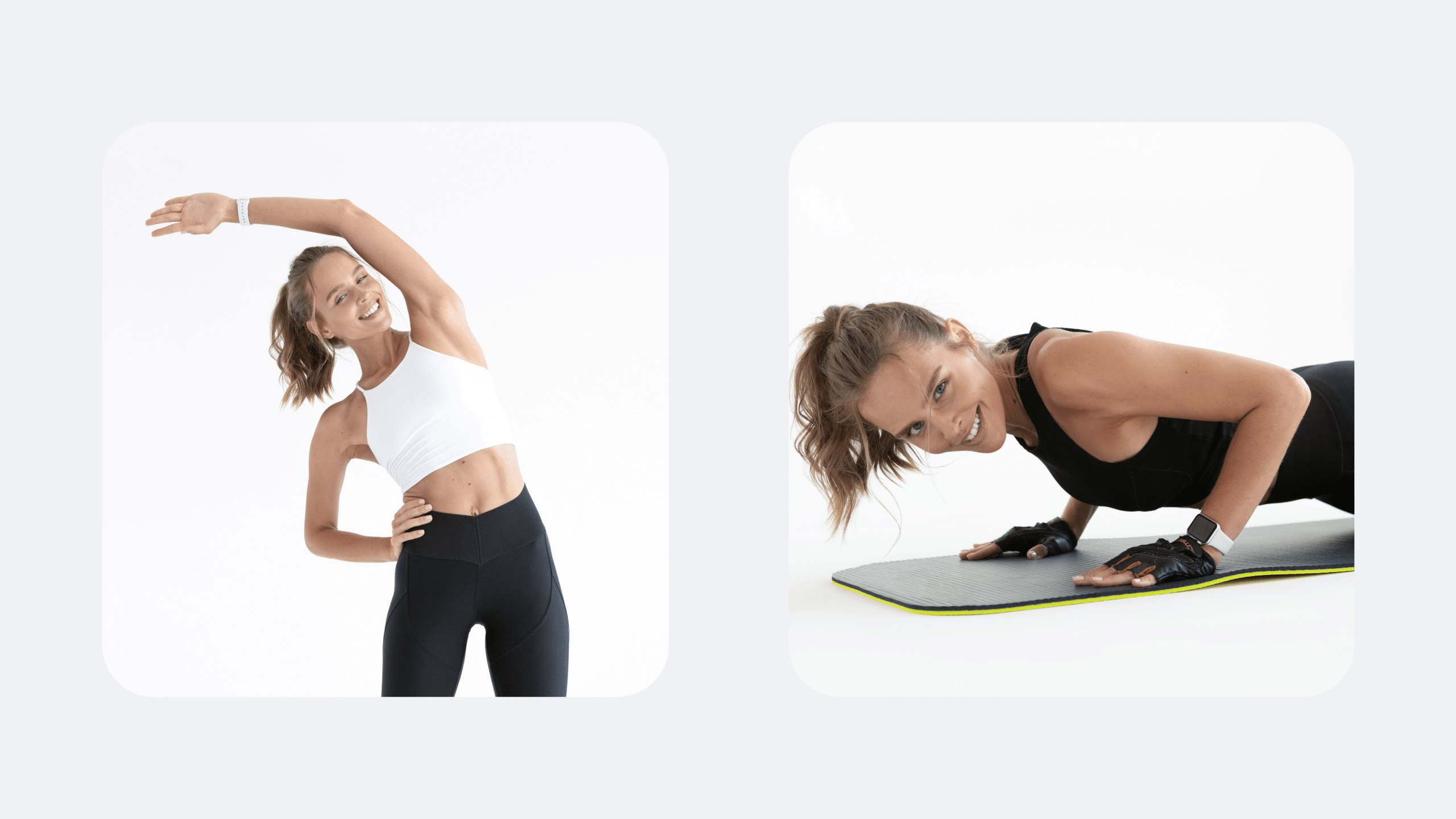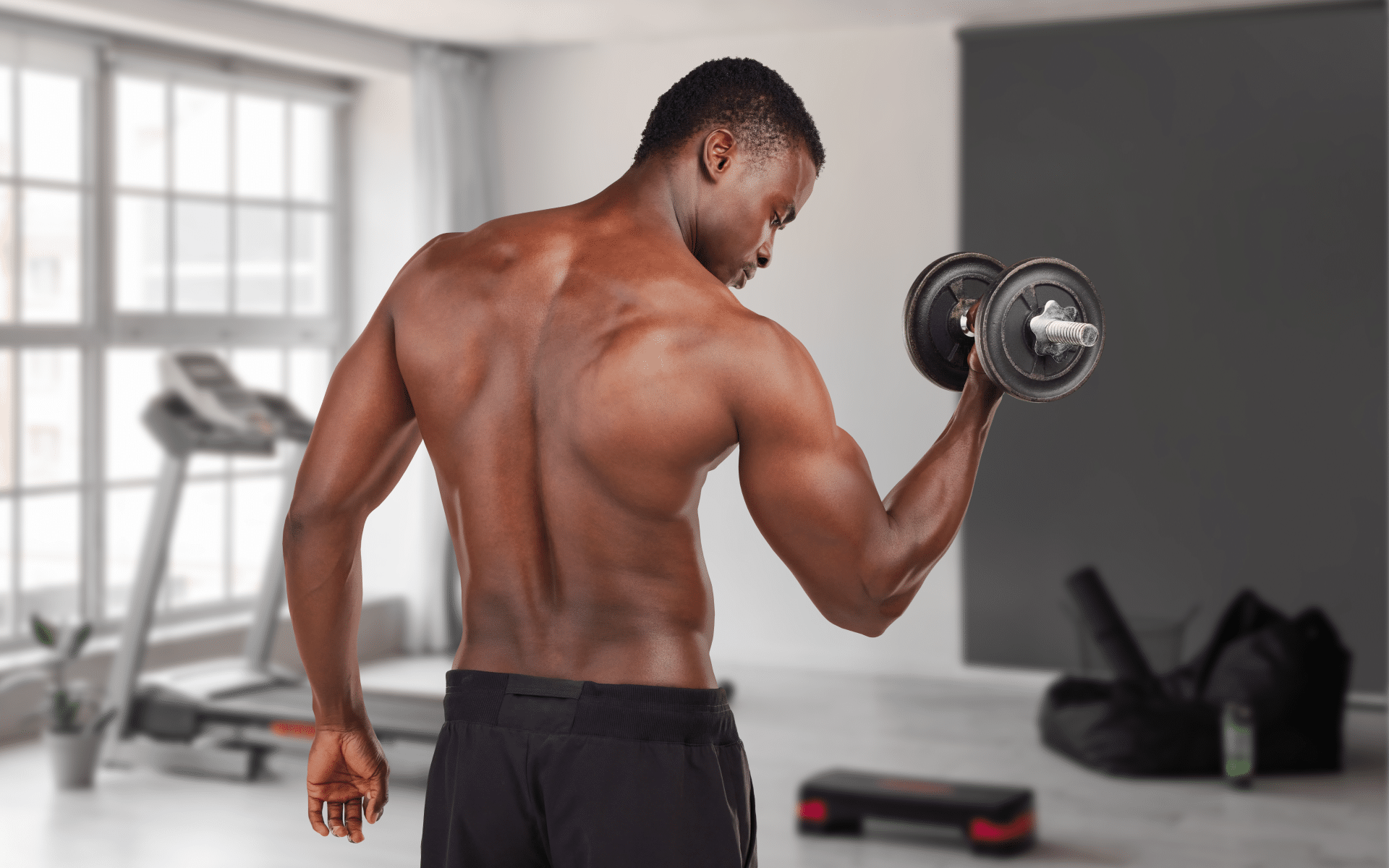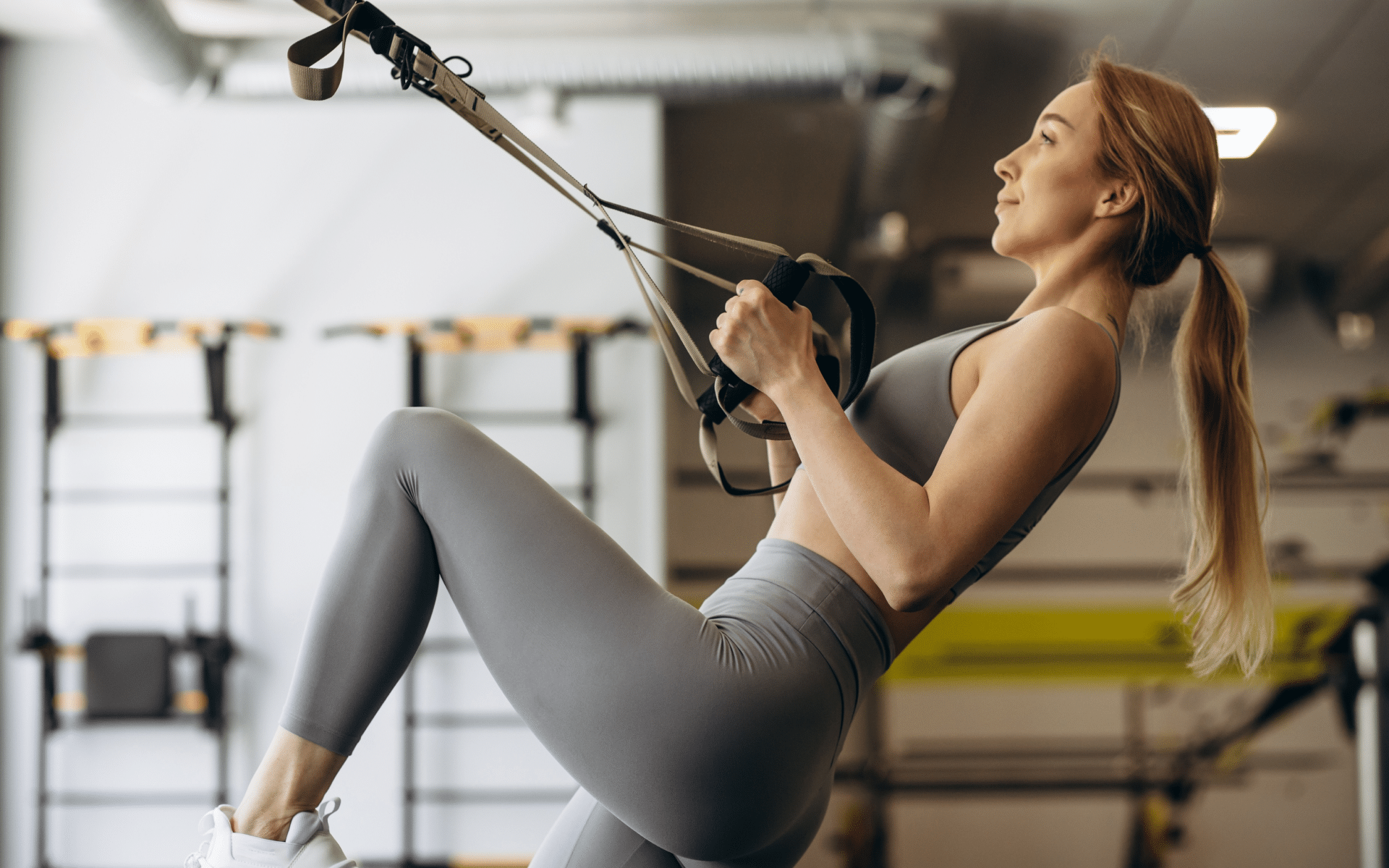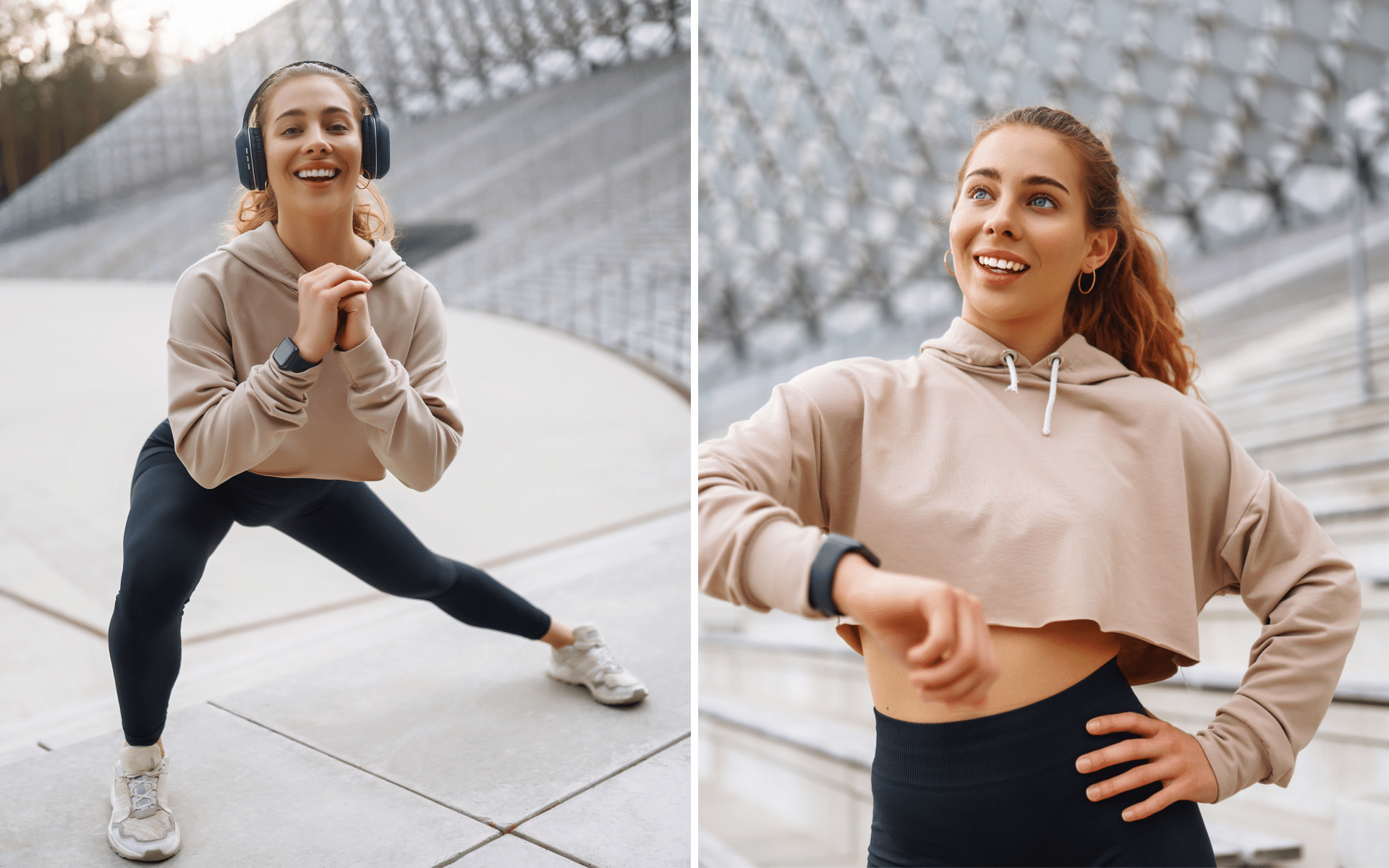A couple of years ago, the plank challenge was all the rage on social media with everyone claiming how good this workout was. While the world seems to have moved on from this trend, the benefits of planks still reign supreme.
If you’re tired of drooling over all those strong beautiful cores and abs on your Instagram/TikTok feed and want to start working on yours, then the 30-day plank challenge for beginners is the best place to start.
In this article, we’re going to outline some plank challenge benefits and show you how to do a basic plank as well as more variations. These modifications to the original will help keep the 30-day plank challenge for beginners men and women fun and fresh throughout the month so you don’t end up bored and give up.
What Are the Benefits of a 30-Day Plank Challenge for Beginners?
If you’re not sure if you should commit yourself to the 30-day plank challenge for beginners, here are some benefits of this exercise that may change your mind and make you hop on the bandwagon:
1. Increased core strength and abs
While abs may not be everyone’s ultimate goal, they are certainly the goal for many. Even if you won’t end up with a six-pack at the end of your 30-day challenge, you will have built and strengthened your core muscles and be well on your way to this goal.
These exercises are great for abs as they work all the muscles in your core, including the rectus abdominis (the “six-pack” muscles you can see), transverse abdominis (your deepest abs muscles), internal and external obliques (your sides), hips, and back muscle, which are a part of your core.
In a study published in the Journal of Exercise Rehabilitation, researchers found that when older adults did plank exercises 3 days a week for 12 weeks, their ability to do sit-ups increased by an incredible 42%, showing that their core strength increased significantly thanks to this one workout (10).
If you tend to let yourself off the hook, raise the white flag when things get tougher than you expected, send yourself on an unconscious binge-eating trip – BetterMe app is here to help you leave all of these sabotaging habits in the past!
2. It’s a full-body workout
What many people fail to realize is that this workout, in whatever variation, exercises more than just your core. As you’re using your hands to hold yourself up, you end up working the muscles in your biceps, shoulders, and arms, making them more toned and developed.
If you hold the correct posture during this workout, you’re also able to work out and build the muscles in your neck, glutes, and thighs, which easily makes the 30-day plank challenge for beginners an everyday full-body workout.
In the above-mentioned study, in addition to increasing the core strength of the older adults, researchers also found doing planks to improve their grip strength (10).
In another study published in Medicina in 2021, researchers following a middle-aged man found that doing elbow planks 5 days a week for 4 weeks made incredible changes to his physical fitness (9).
Not only did his muscle strength, muscle endurance, flexibility, and cardiopulmonary fitness improve, his muscle mass and the basal metabolic rate also increased. They also realized that his body fat mass and fat percentage decreased (9)
3. Strengthens your spine and back muscles
Squats, push-ups, glute bridges, lunges, and pull-ups are some of the popular workouts that can lead to back injuries if they’re not done correctly. These exercises help build the muscles in your back and hips, which gives you a stronger support base for such workouts.
Studies over the years have shown that doing planks helps activate the core muscles in the abdominal and lower back regions and that the strength and endurance developed by these muscles can help strengthen and stabilize the spine, which leads to reduced back pain, improve performance, reduce risk of injury and falls, and much more (10, 8, 6, 5).
4. Boosts your metabolism
By planking on the 30-day plank challenge for beginners, you’re challenging your body and muscles, which helps you burn calories during the workout. However, this doesn’t stop once the workout is over. As planking engages and helps build muscle, it boosts your basal metabolic rate, which means you continue burning calories even at rest.
In a study published in the BMC Sports Science, Medicine and Rehabilitation journal, researchers found that doing continuous plank exercises can help increase the anaerobic capacity of exercisers. They also concluded that intermittent plank exercises can be beneficial for patients with mild and borderline cardiovascular diseases (11).
Basically, participating in a plank challenge for beginners could help increase your anaerobic capacity – the energy that is used when your lungs cannot put enough oxygen into the bloodstream to keep up with the demands of your muscles for energy (3). Your anaerobic metabolism is what you rely on when undertaking highly intense but short bursts of physical activity such as sprinting or lifting heavy weights.
Read more: Does Planking Burn Fat? Unveiling the Truth of the Famous Plank vs. Fat Debate
5. Helps improve your posture and balance
As previously stated, this 30-day plank challenge for beginners will work out your core muscles, which improves your posture and balance. You may not realize it, but your posture and balance are highly dependent on your core stability, and the stronger the core muscles, the more stable your core will become.
In a study published in 2021 in the Journal of Clinical and Diagnostic Research, researchers found that both the traditional planks and modified plank variations helped improve core endurance and core stability (7). In another more recent study in the Journal of Functional Morphology and Kinesiology, researchers found core exercises including side planks, bird dog, and more helped improve and increase total core muscle thickness, which led to better dynamic core stabilization (1).
The researchers advised that doing side planks and bird dog with stomach hollowing could help competitive athletes, normal individuals, and anyone who is undergoing rehabilitation improve their health and physical performance (1). Learning how to do stomach vacuums can help you grasp stomach hollowing and incorporate it with these exercises.
6. Can have a positive impact on mental health
According to a 2018 review, exercise reduces the risk of all-cause mortality, cardiovascular disease, stroke, and diabetes, and also has incredible benefits for mental health. In the study, researchers found that individuals who exercised had 43.2 percent fewer days of poor mental health in the last month than individuals who did not exercise (2).
It should also be noted that popular core-based/core strengthening exercises such as Pilates and yoga have been reported to elicit a positive attitude toward physical self-description and lead to subjective happiness among participants. Those who participate in such exercises have reported improved mood states and quality of life, in addition to fewer feelings of anxiety and depression (14).
How Long Should I Plank?
According to Harvard Health, the longest recorded plank was approximately 4 hours long. However, this isn’t something you can do on a daily basis. In fact, most planks, even those done by experts, rarely go above the 2-minute mark (13).
But how long should a beginner hold a plank for every day? When doing this 30-day plank challenge for beginners, we advise you to try planking for 10 seconds to 30 seconds at a time. While the exercise may look pretty easy, it actually requires a lot of strength to hold the correct position for a considerable length of time, let alone those 10 seconds.
Start by holding each plank position for 10-second intervals – you can choose to push to 20 seconds or even 30 seconds if you feel 10 seconds is too easy or just not enough for you. With time, consistency, and patience, you may realize that you’re able to hold the position for a minute and even longer without collapsing by the end of the 30-day mark.
Just remember that 2 minutes of planks a day is enough. You don’t need to do more than that. If you feel you want to do more abs exercises, we suggest trying some standing core workouts.
Is It Normal to Shake While Planking?
Yes, it’s absolutely normal to shake when planking. When you’re in this position, you’re basically balancing all your weight on your toes, elbows, and forearms (or wrists and palms, depending on the variation) – this is a lot of weight.
You’re also fighting against gravity to hold the position and engaging multiple muscles, including your core, shoulders, arms, and legs, all at once to keep you in this position. Therefore, you get tired faster than you would with regular exercises and start to shake.
As a beginner, your core isn’t strong or stable enough to hold you well throughout the exercise, so you may notice that you start shaking faster/earlier than those who have been practicing the exercise and other core strengthening exercises for longer.
BetterMe app is a foolproof way to go from zero to a weight loss hero in a safe and sustainable way! What are you waiting for? Start transforming your body now!
Can Plank Reduce Belly Fat?
Yes, doing planks can help with muscle growth and a higher resting metabolic rate – two factors that help with fat burning.
However, doing planks alone won’t give you the best or quickest results. For faster results, we suggest you eat healthier meals, find your calorie deficit and stick to it, and do more than one workout.
Doing some full-body resistance training workouts and a number of cardio workouts together with your 30-day plank challenge for beginners and fixing your diet is the best way to reduce belly fat.
What Is the Easiest Plank for Beginners?
When we think about starting this challenge, many of us will automatically try the basic variation either on our elbows or stretched arms with legs straightened out behind us. If you’ve tried either of these versions and find yourself struggling, try the version below, which is considered easier:
Kneeling Plank
- Start in a prone position supporting yourself on bent knees and palms with extended arms and soft elbows (don’t lock your elbows).
- Slightly shift your weight forward and ensure your body is in a straight line from your ears to your knees.
- Remember to breathe and keep your core engaged by pulling your navel to your spine.
- Hold this position for 10 to 30 seconds and do 3 sets.
This variation is said to be good for beginners and people who may have some back problems as it places less stress on your lower back.
How to Do a Plank Properly
If you’ve already mastered the kneeling variation or you feel that it’s a little too easy for you, you can switch to the standard plank, which is also known as the push-up or high plank. Here’s how to do it:
- Start down on all fours, making sure your hands are fully extended and slightly wider than shoulder-width apart.
- Extend your legs and come up onto your toes as if about to do a push-up. Push your toes into the ground and squeeze your glutes for better stability.
- Engage your core and ensure your body is in a straight line from neck to heels. Don’t sag in the midsection, lift your butt into an arch, or look straight down at the floor – try looking at a spot about a foot from where your hands are.
- Keep breathing and hold this basic position for 20 to 30 seconds and perform 3 sets.
Other Plank Variations to Add to Your 30-Day Plank Challenge for Beginners
Low Plank
Also known as the elbow plank, this is done in the same way as the high or standard variation, but instead of balancing yourself on outstretched hands, you hold yourself up on your elbows and forearms.
Side Plank
- Start by lying on your right side, with your legs extended and stacked from hip to feet.
- Place your right elbow directly under your shoulder and ensure your head is directly in line with your spine. Keep your left arm aligned along the left side of your body.
- Engage your abdominal muscles, drawing your navel toward your spine, and keep breathing.
- On an exhale, slowly and steadily lift your hips and knees from the mat. Stop once your torso is straight in line with no sagging or bending.
- Hold this position for 10, 20, or 30 seconds – or as long as you can before returning to the start position on the mat.
- Change sides and do the same on the other side.
If you want to make this variation more challenging, lift the arm that’s not holding you up to the ceiling.
Elbow Planks with Knee Tap
- Start in a low plank position with your hands directly below your shoulders, your core engaged, and your body in a straight line from head to heels.
- Slowly lower and tap your left knee to the ground without moving your hips. Lift your left knee back up, returning to the starting position.
- Repeat the same movement with the right leg. This is one rep.
- Do this for 10 reps or set an alarm and do as many as you can in 20 or 30 seconds.
Planks with Shoulder Taps
- Start in the standard position – arms shoulder-width apart and outstretched beneath you, core engaged, and your body in a straight line from head to heels.
- Keeping your hips square and in position, working hard not to let them sway side to side, lift your right hand to tap your left shoulder. Bring it down and then lift your left hand to tap your right shoulder.
- Make sure you’re well-balanced so you don’t fall over while lifting one hand. Repeat 10 times or set an alarm and do as many as you can in 20 or 30 seconds.
Knee to Elbow Plank
- Start at the top of a push-up position with your hands directly beneath your shoulders.
- Tighten your core and bring your right knee to the outside of your right elbow. Pause here for a moment before straightening your leg back behind you.
- Switch to the left knee and repeat the movement. Aim for 3 sets, 20 to 30 seconds each. You can push it for a minute if you feel able to do so.
Plank Hip Dips
- Start in a low/elbow plank position. Slowly rotate your spine to lower your left hip to just above the floor – approximately 1 or two inches from the floor. Hold this position for 1-2 seconds and then rotate back to the starting position.
- Rotate your spine again and now lower your right hip. Return to the starting position and repeat the whole process all over again.
- Do this for 20 to 30 seconds and perform 3 sets.
Plank Up Downs
- Start in a standard high plank/push-up position. Lower your right elbow to the mat and then your left, coming into an elbow plank.
- Place your right hand on the mat and straighten your right elbow. Do the same on the left to return to a full plank.
- Continue doing this for up to 30 seconds, or more depending on how winded you are. Try doing 3 sets.
Read more: Maximize Your Home Workout: 5 Plank Wall Exercises for a Powerful Core
How Many Planks a Day to See Results?
There really isn’t a given number for how many planks you should do a day to see results. However, as previously stated, the cut-off point for holding the position is two minutes (13). If you break up these two minutes into intervals that can be done throughout the day, you can do anything from 4 to 10 different variations in a day.
| Day | Workouts | Day | Workouts |
|---|---|---|---|
| 1 | Hold a basic plank for as long as possible and ensure you maintain good form | 16 | 30 seconds knee to elbow + 30 seconds side planks |
| 2 | 20 seconds standard + 20 seconds low/elbow planks | 17 | 30 seconds planks with shoulder taps + 30 seconds knee to elbow |
| 3 | 30 seconds elbow plank + 20 seconds side plank | 18 | 30 seconds side planks + 30 seconds hip dip |
| 4 | 20 seconds high + 20 seconds side planks | 19 | 30 seconds planks with shoulder taps + 30 seconds up-downs |
| 5 | 20 seconds high + 10 seconds low + 10 seconds side planks | 20 and 21 | Rest days |
| 6 and 7 | Rest days - let your body and muscles recover | 22 | 30 seconds basic + 30 seconds knee to elbow planks |
| 8 | 30 seconds high + 20 seconds up-downs planks | 23 | 30 seconds with knee taps + 30 seconds elbow planks |
| 9 | 30 seconds low + 20 seconds planks with knee taps | 24 | 30 seconds plank with shoulder taps + 30 seconds plank hip dips |
| 10 | 30 seconds side + 20 seconds hip dip planks | 25 | 30 seconds up downs + 30 seconds high plank with shoulder taps |
| 11 | 10 seconds basic + 20 second low + 30 second side planks | 26 | 10 seconds low + 20 seconds side + 30 seconds up down planks |
| 12 | 30 seconds side + 30 seconds up-downs planks | 27 and 28 | Rest days |
| 13 and 14 | Rest days | 29 | 20 seconds basic + 20 seconds low + 20 seconds knee to elbow planks |
| 15 | 30 seconds elbow planks + 30 seconds with knee taps | 30 | 20 seconds side + 20 seconds hip dips + 20 seconds with shoulder taps |
Can You Do a 30-Day Side Plank Challenge?
Yes, you can. However, it’s important to note that as there aren’t many side variations of this workout, you may get bored of doing the same workout over and over again.
Instead of looking for a 30-day side plank challenge chart for beginners, try incorporating more side planks into the above 30-day plank challenge chart for beginners. You can also try using a plank challenge app to help you stay on track and give you more ideas for plank variations you can do.
The BetterMe App is a great example of this. The app offers core workout challenges and other workout challenges to help give you a well-rounded workout plan.
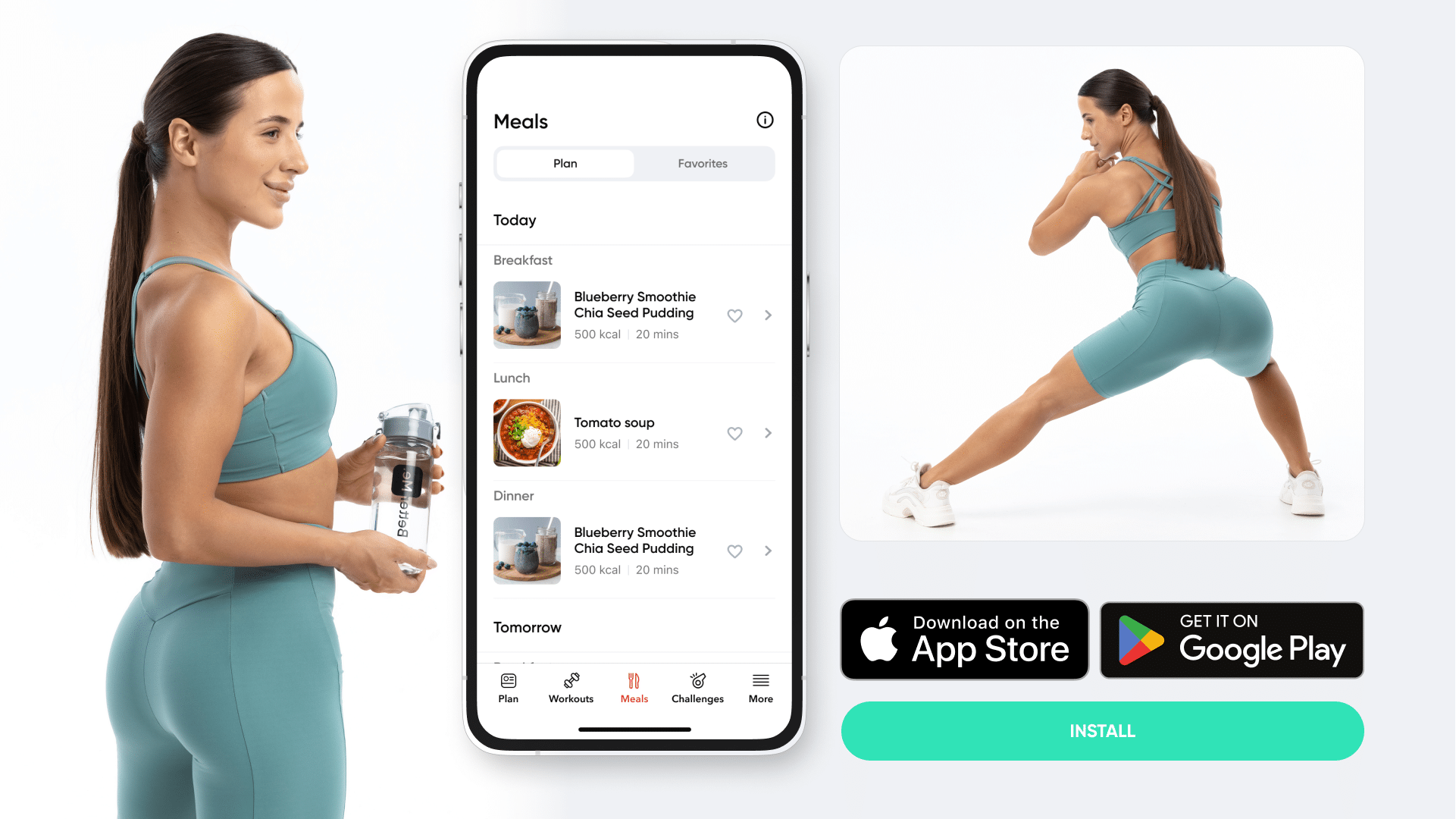
How to Make the 30-Day Plank Challenge for Beginners Even More Challenging
Say you’ve been doing the challenge for two weeks and it has stopped feeling as challenging as it was, what can you do to ensure you keep challenging yourself?
1. Add an incline
Placing your feet on a footstool, box step, or step raises your feet slightly higher than your shoulders and makes your body work harder to maintain stability. This makes your muscles work harder and will burn more calories.
2. Add a medicine ball to your routine
If the added incline isn’t working for you, try using a medicine ball to challenge your stability even further. Plank variations such as the jackknife, stir the pot, and the Spiderman can all be used with a medicine ball for a more challenging stability and core workout experience.
3. Add some resistance
Weighted workouts always burn more calories than sticking to body weight. Challenge yourself by using some resistance bands, dumbbells, or a kettlebell where applicable. If you don’t want to have something in your hands, carrying a full backpack can also work as weights.
FAQs
Do planks reduce waist size?
Yes, they can. As stated in the benefits section above, planks help boost your metabolism, which helps with calorie burning and weight and fat loss. This can ultimately lead to a smaller waist size. For better results, ensure you eat at a calorie deficit and do cardio and full-body resistance workouts.
Is 1 minute of planking a day enough to lose weight?
Yes, it is. Doing a 1-minute plank alongside other workouts can help you lose weight. Please note that while planks are a full-body workout, doing them alone is not nearly enough for weight loss. It’s a good start, but you need to do more for quick and long-lasting results.
Can you get a 6-pack from just planking?
Not really. Planking is a good starting point for building a 6-pack, but it won’t get you there on its own. For the best results, we suggest a healthy calorie deficit diet, in addition to a full-body workout and a variation of other core building workouts.
Full-body workouts help burn fat in your tummy area and planks plus other core workouts exercise and grow the muscles under the fat, making them bigger and giving you the desired six-pack.
Should I lose weight before building muscle?
No, you don’t need to lose weight before building muscle. Research has shown that through body recomposition – the process of using exercise and diet to transform your body shape or physique – both trained and untrained individuals can build muscle and lose weight/fat at the same time (12, 4).
The Bottom Line
The 30-day plank challenge for beginners is a great idea for anyone who wants to start working out and strengthen their core. However, it’s important to note that this form of exercise alone is not enough to help you lose weight or finally get those abs.
To achieve these things, you must fix your diet by consuming healthier, more nutritious foods and add more exercises into your routine. You should do some cardio and include more body weight or weighted workouts in your everyday workout plans.
DISCLAIMER:
This article is intended for general informational purposes only and does not serve to address individual circumstances. It is not a substitute for professional advice or help and should not be relied on for making any kind of decision-making. Any action taken as a direct or indirect result of the information in this article is entirely at your own risk and is your sole responsibility.
BetterMe, its content staff, and its medical advisors accept no responsibility for inaccuracies, errors, misstatements, inconsistencies, or omissions and specifically disclaim any liability, loss or risk, personal, professional or otherwise, which may be incurred as a consequence, directly or indirectly, of the use and/or application of any content.
You should always seek the advice of your physician or other qualified health provider with any questions you may have regarding a medical condition or your specific situation. Never disregard professional medical advice or delay seeking it because of BetterMe content. If you suspect or think you may have a medical emergency, call your doctor.
SOURCES:
- A Comparison between Core Stability Exercises and Muscle Thickness Using Two Different Activation Maneuvers (2024, ncbi.nlm.nih.gov)
- Association between physical exercise and mental health in 1·2 million individuals in the USA between 2011 and 2015: a cross-sectional study (2018, thelancet.com)
- Biochemistry, Anaerobic Glycolysis (2023, ncbi.nlm.nih.gov)
- Body Recomposition: Can Trained Individuals Build Muscle and Lose Fat at the Same Time? (2020, journals.lww.com)
- Canadian Society for Exercise Physiology position stand: The use of instability to train the core in athletic and nonathletic conditioning (2010, pubmed.ncbi.nlm.nih.gov)
- Core stability exercise principles (2008, pubmed.ncbi.nlm.nih.gov)
- Effectiveness of Modified Plank vs Conventional Plank on Core Muscle Endurance and Stability in Recreational Athletes: A Quasi-Experimental study (2021, researchgate.net)
- Effect of using a suspension training system on muscle activation during the performance of a front plank exercise (2014, pubmed.ncbi.nlm.nih.gov)
- Effects of High Intensity Plank Exercise on Physical Fitness and Immunocyte Function in a Middle-Aged Man: A Case Report (2021, ncbi.nlm.nih.gov)
- Effects of plank exercise on respiratory capacity, physical fitness, and immunocytes in older adults (2023, ncbi.nlm.nih.gov)
- Metabolic and cardiovascular responses to continuous and intermittent plank exercises (2023, bmcsportsscimedrehabil.biomedcentral.com)
- New Insights and Advances in Body Recomposition (n.d., frontiersin.org)
- Straight talk on planking (2019, health.harvard.edu)
- The Impacts of Pilates and Yoga on Health-Promoting Behaviors and Subjective Health Status (2021, ncbi.nlm.nih.gov)

